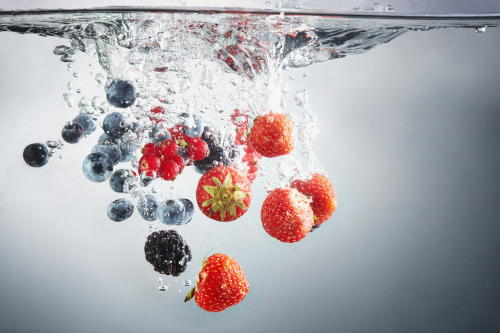Fluid Balance and Fruits & Vegetables

For people with end stage kidney disease (ESKD) on hemodialysis, it can be challenging to keep the body hydrated without becoming “fluid overloaded.” Drinking too much fluid can lead to serious health problems such as high blood pressure, cramping during dialysis, swelling of the feet, legs, hands and face and heart problems (1). At the same time, most people on a kidney diet need to include 2 to 3 servings of fresh fruit (1/2 cup or 1 small fruit) and 2 to 3 servings of vegetables (1/2 cup raw, cooked or frozen) each day that provide essential fiber, vitamins and minerals (2).
How to Balance Fluid Intake with Fruits and Vegetables Intake
How do you know how much fluid is a safe amount to drink? Most people on hemodialysis who do not urinate (pee) need to consume 32 fluid ounces daily.
If you still make urine, measure the total daily amount by collecting your urine for 24 hours. Add the total amount of your urine output to the 32 fluid ounces. For example, if you urinate 16 ounces for the whole day, you can drink a total of 48 fluid ounces per 24 hours. Make sure to include fluid (liquid) beverages such as water, coffee, tea and juice as well as foods that melt at room temperature such as frozen desserts, gelatin and ice. Even though fresh fruits and vegetables contain water, it is not necessary to restrict them from your diet.
Include a variety of fresh fruits and vegetables in your daily diet. For most people eating a variety of fresh fruits and vegetables does not lead to fluid overload. In fact, restricting fruits and vegetables in an effort to manage fluid intake has more harmful effects and health benefits.
Here is an approximate guide to account for the fluid content in certain vegetables (3):
| Vegetable (1 cup) | Water |
| Tomatoes | 6 ounces |
| Zucchini | 6 ounces |
| Cabbage | 5 ounces |
| Okra | 5 ounces |
| Celery | 3.4 ounces |
| Broccoli | 3 ounces |
| Green bell pepper | 3 ounces |
| Lettuce | < 1 ounce |
Here is another guide to account for the fluid content in certain fruits (4):
| Fruit (1 cup) | Water |
| Grapefruit* | 7 ounces |
| Cantaloupe | 5.6 ounces |
| Oranges | 5.5 ounces |
| Mangoes | 5 ounces |
| Peaches | 5 ounces |
| Papaya | 4.5 ounces |
| Blackberries | 4.5 ounces |
| Nectarines | 4.4 ounces |
| Apples | 3.8 ounces |
If you have questions about how many fruits and vegetables to include in your specific kidney diet, talk with your renal dietitian. They can help you plan healthy and safe amounts of fruits and vegetables to enjoy. *Be sure to speak with your doctor or pharmacist to see if you are on any medications that could interact with grapefruit.
REFERENCES:
2. https://www.kidney.org/atoz/content/dietary_hemodialysis
3) https://www.myfooddata.com/articles/vegetables-high-in-water.php
4) https://www.myfooddata.com/articles/fruits-high-in-water.php
Additional Kidney Diet Resources
Visit DaVita.com and explore these diet and nutrition resources:
DaVita Kidney-Friendly Recipes
This article is for informational purposes only and is not a substitute for medical advice or treatment. Consult your physician and dietitian regarding your specific diagnosis, treatment, diet and health questions.

Recent Comments